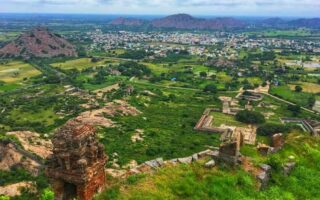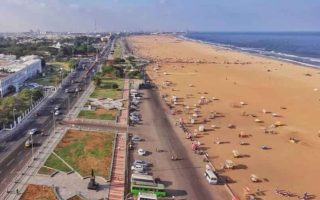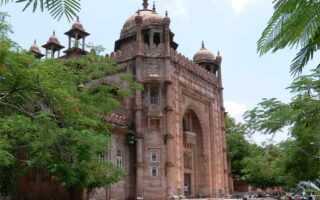- Location: 48 kilometers from Tirunelveli from Tamil Nadu.
- Deity: The temple is dedicated to Lord Murugan, also known as Lord Subrahmanya, one of the most revered deities in Hinduism.
- Well Known: One of the Six Aarupadai Veedu
- Historical Significance: It is one of the six abodes of Lord Murugan and has a rich history dating back over 2,000 years.
- Architectural Marvel: The temple’s architecture features stunning Dravidian style, with intricately carved sculptures and a towering gopuram (gateway tower).
- Unique Traditions: The temple follows unique customs and rituals, including the Kavadi and Soorasamharam festivals, drawing thousands of devotees each year.
- Spiritual Importance: Devotees visit the temple seeking blessings, protection, and guidance from Lord Murugan, especially during times of adversity.
- Seaside Location: Thiruchendur Murugan Temple is situated by the sea, providing a picturesque backdrop for worship and meditation.
- Festive Atmosphere: The temple comes alive during festivals, with processions, music, and a vibrant atmosphere that attracts pilgrims and tourists alike.
- Entry Fee: No entry fee
The Thiruchendur Temple is one of the very impressive temples that is located on the shore and is committed to Lord Subramanya in the Taluka of Thiruchendur in the Tirunelveli district of Tamil Nadu. The temple has one of the six Aarupadai Veedu, a holy place for Lord Murugan while the remaining five abodes are situated in the Padaiveedu are situated on the mounds or the hills. The Thiruchendur temple is situated on the amazing sea shore that is bounded by the east and the north by the sea.
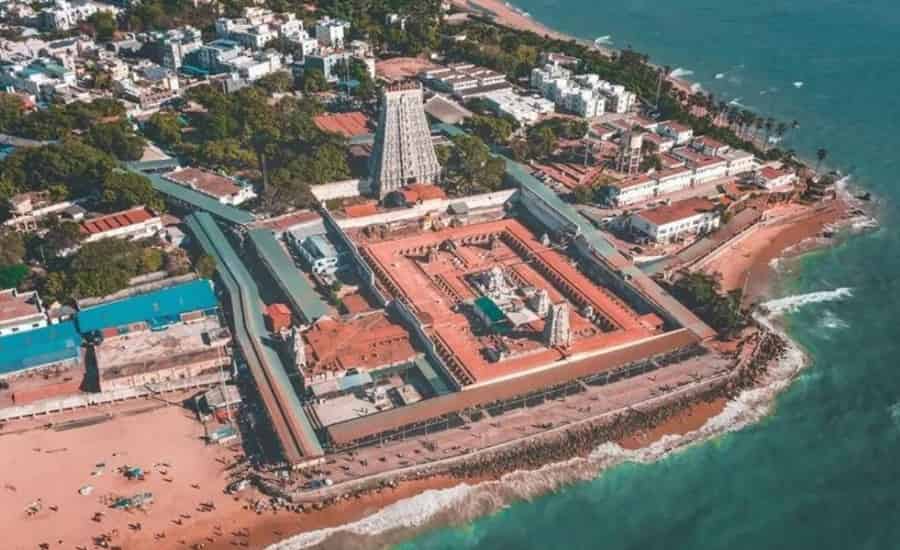
There are many of the beautiful works that are residing in the glory of the Thiruchendur. The work has been brought by the Tamil Sangam which is well known as “Thirumurugatruppadai” along with 83 Thiruppugazh hymns that belongs to the “Arunagirinathar”. It is believed that at this point, Lord Subramanyam annihilated Surapadman, who was with his brothers Taraka and Singamukha was reining Triloka well known as the heaven, earth and the hell or Patala. At the point of his eminence, the demons were subjected to the Lords to untold miseries.
The Devas here are invoked to Lord Shiva for the excellence deliverance. Lord Shiva has his eye full of mercy for the protection and has sent around six fireballs. The God of fire known as Agni is carried away to the Himalayan from the holy Gangas. At this place, they took away the six little babies on the lotus flower who were well nourished by the Krithikanymphs.
All the six babies were embraced by Goddess Parvati who was the consort of Lord Shiva who took an avatar that has six heads and twelve hands which is now popularly known as Arukhmukh and Shanmukh, the six facet. The Lord had taken the journey in this avatar from to Thiruchendur from Kailash with his mission of accomplishing the Asuras. On this point of time, he wanted a shrine committed to Lord Shiva for worshipping him.
The celestial Malan had ordered to construct the temple near the shore. The Lord was on the divine mission and had a fight with the demons and the other hordes for six days on the ground, in air and on the sea. It was end of all but not the Surapadman who took the avatar of the Mango tree and emerged in the center of the ocean surprisingly.
The Lord came in the incarnation of Lord Indra’s had challenged the evil spirits from the isle and had parted the Asuras dividing him into two parts. After the fight, the left put portion of the body turned into the Peacock and Cock and yet never gave up. Even this form was able to fight to their last breathe and demon was penitent in front of the death. It was the point when it was the end of the Auras and the above have presented in the two forms in the form of the Lords.
Temple Timings
- The temple generally opens at around 5:00 AM in the morning.
- The afternoon break or “Uchikalam” occurs from around 12:00 PM to 4:00 PM.
- The temple reopens in the evening at approximately 4:00 PM.
- The evening puja or “Sayarakshai” takes place around 6:00 PM.
- The temple closes for the day after the evening puja.
Key Rituals
- Abhishekam: Devotees can witness the sacred bathing ceremony or abhishekam of the deity, Lord Murugan, performed with various auspicious substances like milk, honey, sandalwood paste, and more.
- Pooja Services: The temple conducts multiple daily pooja services, including the morning and evening pujas, offering prayers, and hymns to Lord Murugan.
- Archanas: Devotees can participate in archana services, where priests chant the 108 names of Lord Murugan.
- Deeparadhana: The lighting of lamps or deeparadhana is an essential part of the evening rituals, creating a serene and spiritual ambiance.
- Processions: On special occasions and festivals, there are grand processions of the temple deities, including the annual Soorasamharam festival.
- Kavadi and Vratham: Pilgrims often undertake vows, known as vratham, and carry kavadi as a symbolic act of devotion during their visit to the temple.
Celebrating the Victory of the Lords
In order to celebrate this beautiful victory, a Festivals is celebrated which is known as Skanda Sashti and is celebrated in Thiruchendur along with the other shrines that belongs to the Lord Muruga for all the six days with the piety and the pomp all around. The final day of the celebration includes the battle of the Surasamharam and is again enacted in its actual forms by the devotees. Again after the success of this mission, it is believed that the lord gets turned into Thiruchendur, waited and prayed to the Lord Shiva which was constructed by the Mayan.
Apart from this tale, it is also discussed that the actual image was regained from the capsized Dutch vessel during the period of 17th century at the convergence of the River Kaveri along the sea that lies from the historic Chola forming the capital known as Poompuhar or ‘Kavirippoompattinam’. This is one of the beautiful image shining in the golden form enshrined in the Pallavaneswarar temple of Poompuhar. Well, the similar image of the Senthil Andavar is also found in the Thiruchaikadu near Pallavaneeswaram. Both of the images are considered to be born or discovered on the shore and both of them portray the form of Skanda in warriorlike position.
Legendary Idol
The image of the temple has its evidence even in history that makes it as the legendary idol. In the period of 1648 AD, the temple was invaded by the Dutch and it was considered as the temple that was mounted with gold. A thundering storm broke out in the high sea which was enough to frighte the men who were carrying this idol of the lord to abroad. Then the theft was filed to Sri Vadamalaiyappa Pillayan, who was the well-known local renter during the period of Nayaks. He was amongst the one who was able to prepare the same kind of idol in the premises of Panchaloha which is the mixture of five metals.
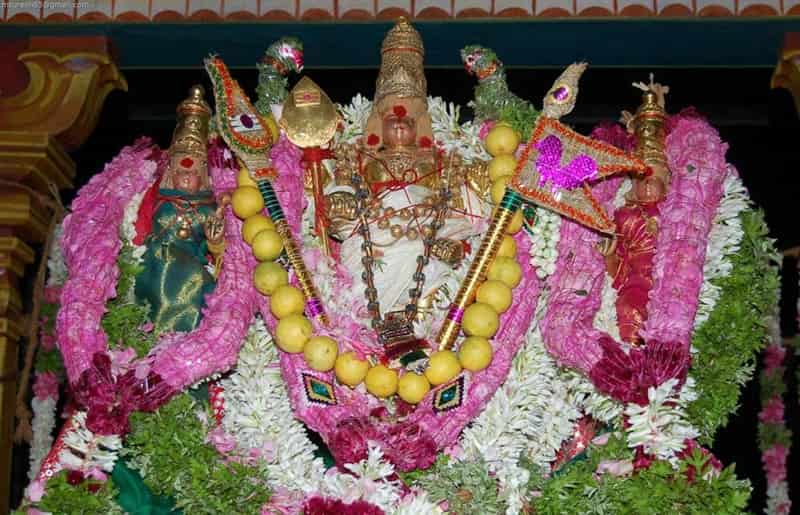
It is this period when the god came in his dream and had ordered him to be in the premises of the sea, and then it was this point where the idol had appeared and also the lime fruit was floating on the way. The Vishnu kite or the Garuda was moving around the sea. Thus, the actual idol was reinstalled and recovered in the temple. Also, a Mandapam was erected by his name and the assets for the concert of the Kattalai for the God on 7th day of the Avani and the Masi festivals.
About The Temple
Even though the shrine belongs to the olden days, the shrine is totally engraved with the structure that is from the 19 -20th centuries. There are also the inscriptions that are seen here from the 9th century and those belonging to the Pandya rulers can be viewed in the temple. It was considered that the temple earlier totally comprised of the rock and it is developed from the structure that is made up of the high hill and later part decorated with the granite.
The temple is a very beautiful structure with the Gopuram of the nine tiered which is about 137 feet high adoring its beautiful entrance and is visible to anyone from the vast distance. The temple has Shanmukha at the entrance. And it also has the Vilaasa Mandapam with many of the carved pillars.
The Inner Prakaram
Near the Subramanyar’s sanctum, there is a Senthil Andavar Sanctum located in the imaged that belongs to the Subramanyams along with his consort. The Prakarams lying in the inner most part are facing towards the south in the way of Arumugasamy turning towards the south. In the inner most Prakarams there are in all 63 Nayanmars and the idols of the Natarajar, Karaikal Ammaiyar along with many others.
There are the shrines of the Valli and the Devasena situated outside the enclosure as described above that lies in the inner most of Prakarnas. There are pillared corridors lying in the outer most Prakarnas along in the house of the Dakshinamurthy which is Mukkuruni Vinayagar and the Arunagirinatha.
The northern part of the outer most Parakram is the shrine dedicated to the shrine of Venkatachalapati who is also known as the Nellai Govindan in addition to the other sub shrines present here in the form of the Gajalakshmi, pallikonda and the Ranganatha along with this consorts.
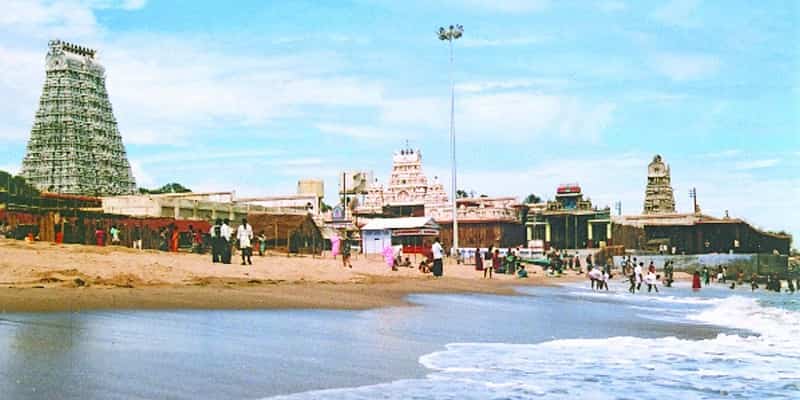
Skanda Pushkarini
The Naazhi Kinaru and the Skanda Pushkarini are the step well and are considered to be sprung upon the Skanda spear graved inside the ground. It has the outer and the smaller well situated in this region. There is brackish water inside the outer well where as there is a fresh and the clear water present inside the inner most well. The protocol to worship Kumara Tantrum has been seen here. This is a similar manner to that of the Keralites temples. The Subramanyar has eight types of offerings to the deities every day.
An Amazing Location
This temple is located in the shore that belongs to the Bay of Bengal and the sanctum situated in the caves. Tamilians have deep faith in Lord Muruga. They assign the Muruga to the kurinji or to the hilly regions. The sun rises in a beautiful way giving a picturesque view in front of the sea. It is skirted by the ocean from the north and the south direction. The temples are swayed with the beautiful waves that are coming and flowing near the temple coming from the Gulf of Mannar. The temple has its origin from the ancient period belonging to the Puranics.
The actual entrance of the Thiruchendur temple is directed in the south and emerged into the foremost temple which is known as the Sivili Mandapam. The entrance has a very huge Mandapam that is in front of the temple from where the sanctum to the Lord Shanmukh along with his ensemble. This place is termed as Shanmukh Vilasa.
Alongside of the west of the south part lies the first Prakaram situated a beautiful shrine of the Dakshinamoorthy facing towards the south. Apart from this, there lies another Mandapam which is located in the west of the temple. This is the place where all the rituals and the Pujas are being performed during the time of the festivals. The annual Thirukalyanam and the Valli on Panguni Uthiram day the rituals are performed in this Mandapam.
The statue of the lord Subramanyam in the form of the peacock is situated in the north wards direction on the western portal. There are many Shivalingams placed one after another. Now, it is the turn of the Arunagirinathar. The statue of the author from Thiruppugazh that is positioned in the separate sanctum. The Melagopura is another portal lying in the western part is situated at the center of the temple.
The most important the Gopuram stands of the western part are lying outside the door. You can have a look at a huge idol of Lord Ganesha entering the devotees that are actually known as Mukkuruni Pillaiyar.
The idol of the Venkatesh is also found in the standing position inside the temple. Along with this there is a carved grotto of that of Gajalakshmi, Sridevi Pallikonda Ranganathar, Neeladevi and Bhudevi. The well-known twelve alwars are depicted in this region.
The Miracle
There is much artistic beauty that belongs to the temple. There are amazingly carved arts and the sculptures that beautifies the temple that is visible on the many of the lingams done on the single part of the stone. The most important and the main edifice of the temple is the Raja Gopuram that is situated on the western part of the temple has the striking element. This part of the temple is associated with the most amazing and interesting story connected to its construction.
There are around 300 years Desikamurthiswamy of Maha Sannidhanam of Tiruvavadurai Mutt was intended, in his dream along with the work of erecting this tower. Considering the situation of poverty, the swami was not able to pay wages to his laborers. So, he then decided to give the wages in the form of the ashes. It was believed that the ashes was turned into the coined of the gold as the laborer pass from the Thoondugai Vinayagar shrine. This miracle got resulted after entering the sixth storey and it has been passed the miracle used to cease.
Poojas and Services
The pooja been performed here are dedicated to the Subramanyam and the Lord Shiva. The most important deity here is the Subramanyam and Shanmukhas are followed with the ritual known as Abhishekam which is performed 3 times every day. The rituals that belong to the Shanmukh are performed by the Namboodris. It is then followed by the Rahasya Deeparadhans that is performed behind the curtains of the temple.
Festivals
- There are 2 main annual Brahmotsavams that is held during the month of August to September and in the month of February to March.
- Skanda Sashti festival is celebrated during month of October to November and in Visakam Festival during the month of Visakam Festival during the month of May to June.
Best Time to Visit
Thiruchendur Murugan Temple, nestled in the town of Thiruchendur in Tamil Nadu, experiences a tropical climate. The region encounters warm and humid weather for most of the year. The best time to visit this sacred site is during the winter months, from November to February, when the climate is milder and more pleasant, providing a comfortable environment for devotees and tourists to explore the temple and its surroundings.
How to Reach
To reach Thiruchendur Murugan Temple, you have several transportation options. The nearest airport, Tuticorin Airport, is located approximately 39 kilometers away, while Tuticorin Railway Station, just 38 kilometers from the temple, is the closest railway station. For those traveling by road, the temple is accessible via National Highway 7 or 44, depending on your departure location, and it is well-connected to neighboring towns and cities through a network of roads. From the major city of Madurai, it’s approximately a 170-kilometer journey by road, which takes around 4-5 hours by car, making it a feasible and well-connected pilgrimage destination.
Where to Stay
Thiruchendur offers a range of accommodation options to suit various budgets and preferences for those visiting the Thiruchendur Murugan Temple. You can find hotels, lodges, guesthouses, and even some ashrams in the vicinity of the temple that cater to the needs of pilgrims and tourists. Some popular options for accommodation include the Thiruchendur Murugan Temple’s own guesthouses, as well as various hotels and lodges in the town. It’s advisable to make reservations in advance, particularly during the peak pilgrimage seasons and festivals, to ensure you have a comfortable stay in this holy town.
- Also Read: Popular Hindu Temples in Tamilnadu
